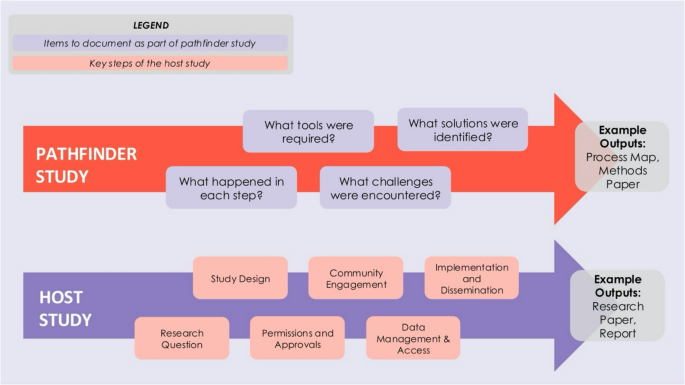Informed by an expert group discussion, a practical approach was developed to help inform and drive the implementation of a uniform method to advance the quality and quantity of data-driven research in resource-limited settings through the documentation of common challenges, solutions, and tools. Accordingly, the foundations of the proposed approach lay in process mapping to document key steps undertaken, challenges encountered, solutions proposed, and tools used throughout individual health research studies, using a standardized framework. This add-on study approach was named “Pathfinder”.
At its core, a Pathfinder study is a research diary, where key processes of producing data-driven health research are mapped. Pathfinders track and process map what are referred to as “host studies”, which are actual health research studies that are either being planned, underway, or complete. One may conceptualize a host study as “what is being done”, and a Pathfinder study as “how it is being done”. Accordingly, we distinguish between two types of Pathfinders: retrospective and prospective. Namely, research teams can use Pathfinders to either retrospectively capture steps and processes in studies that have already culminated, or prospectively capture steps and processes as host studies are undertaken. The key difference is that prospective Pathfinders can be used for quality improvement as a host study is being undertaken, whereas retrospective Pathfinders intend to capture best practices from a host study that has already been completed.
Figure 2 illustrates the difference between a host study and its associated Pathfinder study. Pathfinder studies may be carried out by members of the host study team, a different team, or a mixture.

Using a Pathfinder study to track and map host studies
Accordingly, a Pathfinder study, as an add-on to a host study, can be used to: [1] identify and record the component steps required for the host study to be completed successfully [2], track key metrics, such as time taken and resources required, for each of these component steps to generate a process map [3], support a prospective host study in identifying barriers and finding solutions that enable the achievement of their research objectives, and [4] capture and share the tools, methods, technology or governance processes used in solving challenges encountered in the host study.
Pathfinder teams are guided by a template protocol (S1 Appendix: Pathfinder Study Template Protocol) and may adapt this according to the specifics of their corresponding host study. This protocol may be used to obtain necessary approvals to conduct Pathfinder studies alongside host studies.
Figure 3 outlines a simple process mapping framework according to this protocol, which is elaborated on in S2 Appendix: Pathfinder Tracker. The rows in Fig. 2 depict key component steps, whereas the columns depict key elements tracked. This framework, called the Pathfinder study process mapping matrix, captures and tracks metrics on what activities took place to complete each step, what challenges arose, what solutions to those challenges were, what tools were used, and links to helpful resources and training that were required to achieve each step. In addition, Pathfinder teams are encouraged to comment on the difficulty level of achieving each component in the host study.
Basic Pathfinder study process mapping matrix
This framework can be adapted by Pathfinder teams and helps track the component steps that occur as a host study is designed, implemented, and reported. Component steps include elements such as setting the research question, selecting a study design, obtaining necessary approvals to undertake the host study, working with the community, designing and undertaking the analysis, generating high-quality evidence, and capturing how this evidence is to be taken up into policy and practice. Tracking component steps entails several things: [1] capturing key metrics such as time taken and resources required [2], recording how each step was undertaken [3], noting the tools and methods that enabled new evidence generation, and [4] capturing challenges and solutions.
Like we distinguished between two kinds of Pathfinder studies, it is important to distinguish two kinds of host studies. Firstly, host studies may ask new questions of existing data (secondary data), or secondly, they host studies may generate new information (primary data). We distinguish these two broad categories of host studies because their component steps look slightly different. Pathfinder studies that are mapping the process of asking new questions of existing data may focus more on data infrastructure and access, whereas those that are mapping the process of generating primary data may focus more on data collection. Figure 4 outlines key component steps in each type of host study, and how associated Pathfinder Studies may map these steps.
Schematic of two host studies: [1] primary research study and [2] a study that is asking new questions of existing data
As more Pathfinder studies are undertaken, through iterative learning-by-doing, and identifying when a roadblock is met, host study teams can be supported to identify a solution (Fig. 5). It is likely that another team will have met this roadblock before, and their solutions will have been tracked through the Pathfinder method. Consequently, the wider utility of aggerating findings from multiple Pathfinder studies are to: [1] build a database of process maps, categorized by host study design and topic area (e.g. epidemiology, social science, lab-based studies), and [2] build a database of host study steps, challenges, and solutions shared. Together, these objectives will help build global health research capacity by enabling high-quality data-driven health research.
Iterative process of the Pathfinder method
link

